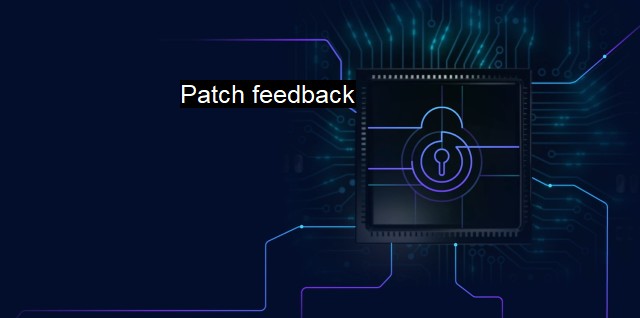What is Patch feedback?
The Importance of Patch Feedback in Enhancing Software Security: Collaborative Information Sharing between Antivirus and Software Vendors
Patch feedback refers to the crucial communication process that takes place between software developers, system administrators, and/or patching tools, providing valuable information about the functioning of patches.An understanding of patch feedback is essential to recognize how this process contributes to maintaining the security posture of systems and networks in the tech world. Patches are software and program updates aimed at fixing security vulnerabilities and other issues. They’re crucial components in ensuring system health and safety against cyber threats. Developers of antivirus or cybersecurity software release patches to tackle vulnerabilities that might be otherwise exploited by hackers.
Once a patch is distributed and applied, feedback on its performance is needed to assess its effectiveness. This communication loop is known as patch feedback. For instance, if a newly applied patch unintentionally disrupts system performance, crashes services, or fails to fix the vulnerabilities it's supposed to address, the affected users or automated system tools would need to communicate these issues. This feedback then reaches the software developers, who can then make the necessary changes to both the immediate patch and future versions to optimize operation and system protection.
Patch feedback isn't limited to information on errors and faults. It also provides valuable information about the aspects of a patch that work well, streamlining the process of applying future patches. Users may communicate about the user-friendly features of a patch, clear and straightforward instructions, or the simplicity of applying the patch, aiding developers to understand what to maintain in future creations.
Patch feedback doesn't just significantly assist software and antivirus developers; it's also beneficial for system administrators. In an organization, system administrators are responsible for ensuring the system runs smoothly—they're the ones to deal with patch management. Patch feedback can supply system administrators with crucial information on whether a patch was successfully installed and applied throughout the organization.
Patch feedback plays an indispensable role in developing more effective future patches and providing insights for intelligent decision-making in terms of risk management and emerging threat response.
In an age where cyber threats are ever-evolving, the importance of effective patch feedback cannot be understated. Fast and clear feedback mechanisms can help developers promptly identify issues, improving response time and ensuring systems are protected in enhanced and robust ways. Timely feedback allows issues to be identified and isolated before they wreak havoc on a system or escalate into major cybersecurity incidents.
Antivirus vendors and other cybersecurity companies might employ a variety of tools and methods to gather patch feedback, like automated system tools, online surveys, user forums, and direct lines of communication like feedback forms and emails. The way patch feedback is collected often relies on the system arrangement, the nature of the software, and the distinct culture of the organization or developer.
Ensuring accurate and helpful patch feedback often requires educating end-users or system administrators. Some operations might have to encourage users to actively provide feedback, especially in cases of successfully applied patches where users might not consider providing feedback necessary.
Hence, patch feedback is an interplay between software developers, system administrators, active users, and automated tools. It provides an indispensable feedback loop promoting and enhancing overall system safety by refining patches. The feedback, whether about the effectiveness of security patches or usability improvements, allows vendors to improve the antivirus or cybersecurity solution, leading to advanced security resilience over time.

Patch feedback FAQs
What is patch feedback in cybersecurity and antivirus?
Patch feedback is a process where security patches are reviewed and assessed for their effectiveness in addressing vulnerabilities in software and systems. Feedback is provided on the reliability, stability, and performance of the patches to ensure they are safe and secure to deploy.Why is patch feedback important in cybersecurity?
Patch feedback is critical in cybersecurity to ensure that security patches are effective in fixing vulnerabilities and protecting against potential cyber threats. Without feedback, patches may not be effective, could introduce new vulnerabilities, or cause system instability.Who is responsible for providing patch feedback in cybersecurity and antivirus?
Patch feedback is typically provided by cybersecurity experts such as security analysts, penetration testers, and ethical hackers who have expertise in identifying and assessing vulnerabilities in systems and software.How can patch feedback improve cybersecurity and antivirus?
By providing feedback on patches, cybersecurity professionals can help improve the accuracy and effectiveness of security measures. This can help prevent cyberattacks, reduce risks, and protect sensitive data from unauthorized access. Additionally, patch feedback can help organizations stay compliant with regulatory requirements and prevent legal consequences resulting from security breaches.| | A | | | B | | | C | | | D | | | E | | | F | | | G | | | H | | | I | | | J | | | K | | | L | | | M | |
| | N | | | O | | | P | | | Q | | | R | | | S | | | T | | | U | | | V | | | W | | | X | | | Y | | | Z | |
| | 1 | | | 2 | | | 3 | | | 4 | | | 7 | | | 8 | | |||||||